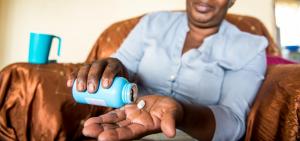In Guinea, a fight to end mother-to-child HIV transmission
Conakry – When Rama learned that she was pregnant, her joy soon gave way to a wrenching anxiety that remained until the moment of delivery: she discovered at the same time that she was HIV-positive and wanted only for her child to be born free of the virus.
“My daughter was born with HIV. I couldn’t protect her because I wasn’t aware of my status prior to my pregnancy,” said the 38-year-old mother of two. “In the case of my second child the doctor explained that it was entirely possible to have a healthy, HIV-negative child if one takes medicine faithfully.”
“I respected those guidelines but all along, I was terrified for my baby,” she added.
In Guinea, 1.5% of the population is living with HIV, with a similar rate among pregnant women, according to the 2018 Demographic Health Survey Report. Children of HIV-positive women are at risk of infection during pregnancy, delivery and breastfeeding. To protect these children, the government has made prevention of mother-to-child transmission a priority so that women living with HIV can give birth to health children.
“HIV/AIDS poses a major threat to public health. Preventing mother-to-child transmission is essential in the fight and I’m delighted to see HIV-positive women in Guinea giving birth to healthy children free of HIV,” said Dr Youssouf Koïta, Coordinator of the HIV/AIDS and Hepatitis Prevention Programme.
At prevention of mother-to-child transmission centres, pregnant women and their children are offered free antiretroviral medications. By 2021, Guinea had 487 such centres, having added 130 within three years.
A 2021 report by the country’s National AIDS and Hepatitis Prevention Programme indicates that of 2252 children tested for HIV between 1 January and 31 December 2021, 93% tested negative, up from 91% in 2020 – a clear sign of success for the transmission prevention programme.
In Guinea, World Health Organization (WHO) is supporting the government to accelerate the elimination of mother-to-child transmission of HIV and in providing paediatric HIV treatment.
“We also provide support in developing guidelines and in improving basic treatment,” explained Dr Casimir Manengu, acting WHO Representative in Guinea. “At the centres, people living with HIV are treated following WHO recommendations, aimed at guaranteeing essential aspects such as the quality of screening tests, viral load and surveillance.”
With WHO guidance, Guinea has developed over the years the ‘R3M’ (third-month appointment) and ‘R6M’ (sixth-month appointment) strategies, which are differentiated antiretroviral delivery models for stable patients with suppressed viral loads. The strategies are designed to maintain treatment while lowering costs, reducing provider workload, and improving service quality.
This delivery model was available to Rama for the birth of her second baby. The prevention of mother-to-child transmission programme is supported by the Global Fund and Unitaid.
“Thanks to the treatment and the excellent follow-up I received, (my second child) was born safe and sound,” she said. “Back when I had my daughter, I would have to bring her in once a month for her medications. Sometimes there were glitches that caused us anxiety. Now the situation is much improved. We receive treatment reliably every three or six months, glitch-free.”
Dr M’Mawa Bangoura runs paediatric HIV/AIDS treatment at the Institute for Child Nutrition and Health at Donka Central Hospital Unit in Conakry. For her and her teams, treatment is a must for all expectant mothers living with HIV.
“Ideally, all children born to HIV-positive mothers should be screened at six to eight weeks,” she said. “The mother should be under treatment for the child to survive. We rigorously monitor these patients from pregnancy through to delivery. We give them hope and impress upon them the importance of adhering to the prescribed treatment. If they do, it’s easily possible for a child to be born HIV-free to two HIV-positive parents.”
Since the introduction of the national strategies, Dr Bangoura has noted progress at all levels.
“We’ve seen an improvement in the performance of service providers, in the quality of care, and in the satisfaction of patients as well,” she said. “In the first quarter of 2021, 586 patients were treated at our centre in Donka. Today, all our patients respect the protocols.”
At home in the suburbs of Conakry, Rama continues to enjoy life with her two children.
“My daughter and I adhere to our treatment and faithfully take our antiretroviral medicines,” she said.
And her second child is now a 13-year-old full of life.
“Each time I look at him, I’m amazed,” said Rama.
“That’s what this treatment has afforded me: the chance to watch my child grow up in excellent health, with a head full of dreams that I know he will succeed in life,” she added, her eyes shining with the promise of a better tomorrow.



